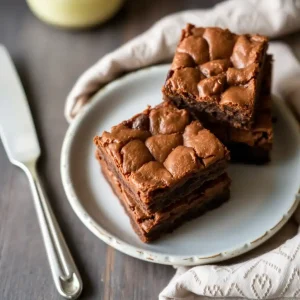The roasted leg of lamb with potatoes and carrots embodies a quintessential Easter feast, weaving together the succulence of lamb with the earthy tones of potatoes and carrots.
Seasoned gracefully with garlic, herb, and butter, this oven-roasted classic effortlessly marries simplicity with culinary elegance.
It’s an easy lamb leg recipe that promises to deliver not just a meal, but a memorable dinner experience.
Each bite invites a celebration of flavors, making every occasion it graces, truly special.
Table of Contents
ToggleEasy Greek Leg Of Lamb Recipe
Cooking a leg of lamb might seem intimidating at first, but with this easy recipe, you’ll see it’s quite straightforward.
This dish, ideal for Easter or any festive gathering, pairs perfectly with roasted vegetables like potatoes and carrots.
The secret to a mouth-watering lamb is in the seasoning – a blend of garlic and herbs that infuses the meat with rich flavor.
Unlike other roasts that require constant attention, this one needs minimal hands-on work.
Simply prepare your lamb, place it in the oven with your vegetables in the same pan, and let it cook.
Remember, keeping an eye on the cooking time is crucial to avoid an overcooked exterior or an underdone interior.
Typically, it takes just a few minutes of preparation and the rest is done in the oven, leaving you free to focus on other sides or tasks. Plus, the leftovers make for an excellent sandwich the next day.
What Is Leg Of Lamb?
A leg of lamb is a substantial cut from the back haunches of the animal and can come bone-in or boneless.
A bone-in leg, often weighing several pounds, can serve numerous people, making it a fantastic choice for gatherings.
The boneless version, while weighing less, still offers ample servings and is sometimes sold with the shank attached, known as shank-on.
This cut is deeply cherished in American cuisine for its presentation and deep, complex flavor.
Drawing from personal experience, mastering the leg of lamb with its robust flavors and tender texture has transformed many family dinners and celebrations.
Its versatility and the ease with which it pairs with various sides make it a staple in my cooking repertoire.

Ingredients You’ll Need For Boneless Leg Of Lamb Recipe
- Herbs: A blend of fresh or dried herbs will infuse your lamb with aromatic flavors. Mustard, either Dijon or yellow, acts as a wonderful base for a marinade.
- Potatoes: Choose between baby, fingerling, or Yukon Gold potatoes for roasting. These varieties work well as they can be used whole or cut down to size.
- Carrots: Whether opting for baby carrots or regular ones, ensure they’re prepped and cut to uniform size for even cooking.
- Prep Time: Taking the time to substitute or find the right place for each ingredient left out can make all the difference in your dish’s outcome.
Oven Roasted Leg Of Lamb With Potatoes And Carrots
Ingredients
For The Lamb
- 1 leg of lamb (5-6 pounds)
- 2 cloves of garlic, finely minced
- 2 tablespoons of olive oil, plus more as needed
- 1 tablespoon of Dijon mustard
- 1 tablespoon of fresh rosemary, finely chopped
- 1/2 tablespoon of fresh thyme, finely chopped
- 1 teaspoon of dried oregano
- 1 teaspoon of salt
- Freshly ground black pepper, to taste
For The Potatoes
- 1.5 pounds of baby potatoes, sliced Hasselback style
- 4 large carrots, peeled and cut into thick slices
- 1 tablespoon of olive oil
- 1 tablespoon of fresh rosemary, chopped
- Salt and freshly ground black pepper, to taste
- 2 heads of garlic, halved horizontally
Instructions
- Preheat your oven to 450°F and place a roasting pan inside to heat up. This initial blast of high heat is crucial for a perfectly roasted exterior.
- Pat the lamb dry using paper towels. Mixing garlic, oil, mustard, herbs, salt, and pepper in a bowl, create a marinade that you’ll spread all over the leg of lamb.
- Once the roasting pan is hot, add a splash of oil and carefully place the seasoned lamb onto it. Let it sear for 10 minutes in the hot oven to lock in the flavors.
- Reduce the oven temperature to 360°F and roast according to the desired internal temperature: for Medium, aim for 145°F to 150°F; for Well-done, go up to 160°F. A rare roast should hit 135°F, though it’s less recommended by the USDA. Depending on the size, this could take anywhere from 50 to 90 minutes.
- About 30 minutes before the lamb is expected to be done, add potatoes and carrots tossed in olive oil, salt, pepper, and rosemary around the lamb in the oven. This ensures they are beautifully roasted and absorb the meat’s flavors.
- Once cooked, let the Greek leg of lamb recipe rest on the counter for 10 minutes before slicing. This resting period allows the juices to redistribute, making every slice succulent and tender.
Side Dish Inspirations
When I think of the perfect side dish ideas to accompany a roast lamb, my mind immediately drifts to a big, green salad drenched in white balsamic vinaigrette.
It’s not just about the lamb, potatoes, and carrots; it’s about creating a festive meal that brings everyone together.
Imagine serving this roasted leg of lamb with potatoes and carrots recipe on a large platter, family-style, where a seemingly odd choice like a bed of Lebanese rice or Middle Eastern pilaf becomes the star, bringing a unique twist to the table.
The option to forego potatoes for these grains is there, but should you choose, a Greek salad, fattoush, chickpea salad, or tabouli can add that fresh element your palate craves. And let’s not forget a little tzatziki as the perfect accompaniment to the rich flavors of the Greek lamb.
As for the leftovers, they keep well in the fridge for a few days, provided they’ve cooled before transferring to tight-lid glass containers to refrigerate.
You can freeze the cooked lamb leg, carefully carved to remove the bone, and store in freezer-safe containers or zip-top bags for a couple of months.
When ready, simply thaw overnight in the fridge. Reheating the thawed or refrigerated meat in the oven, covered with a bit of liquid in the baking pan, ensures it’s warmed through without losing its succulence.
Expert Tips For Buying Lamb Leg
- Grocery Stores vs. Butcher: While lamb leg can be found at grocery stores, visiting a reputable butcher might get you a better quality cut. Don’t hesitate to ask questions about the market weight, age, and origin of the lamb.
- Understanding Lamb: The age of the lamb can affect the flavor of your dish. Baby lamb tends to be more tender and less gamy than mutton, which is older and tougher.
- Fat Content: Look for a leg with a thick outer layer of fat. This insulates the meat during cooking, keeping it tender.
- Trust Your Butcher: Establishing a good relationship with your butcher can ensure you get the best cuts. A trustworthy butcher will also trim any excess fat if asked.
Tips For Perfect Oven Roasted Leg Of Lamb With Potatoes And Carrots
- Internal Temperature: Always use a meat thermometer to ensure your lamb reaches a safe temperature. It’s the most reliable way to avoid under or overcooking.
- Resting Time: After removing your lamb from the oven, let it rest on a cutting board and cover it with foil. This allows the meat juices to redistribute, preventing it from being dry.
- Vegetables: When roasting vegetables alongside, cut them medium to large depending on the size of the leg. This ensures everything cooks evenly.
- Not Done?: If the lamb is not done after the recommended time, set it aside in a casserole dish and finish cooking in the oven.
- Heat Up: To avoid a cool center, make sure the lamb is properly heated through before serving.
- When Unsure: If unsure about doneness, it’s better to err on the side of medium rather than well-done to preserve tenderness.
- Dryness: To combat potential dryness, keep a close eye on the internal temperature and adjust your cooking time accordingly.
- Finish Cooking: Allow your simple roasted leg of lamb with potatoes and carrots to finish cooking from the residual heat after being taken out, especially if the center needs just a bit more time.

Bone-In Leg Of Lamb Cooking Time
The cooking time for a leg of lamb in the oven varies, but a good rule of thumb is to budget about minutes per pound for it to be medium cooked, with a pink hue on the inside.
The internal temp should register at around degrees F when it’s just right. Properly heated, the lamb becomes falling apart tender, offering a succulent meal that’s hard to resist.
Balancing the oven’s temperature with the meat’s size ensures a perfectly cooked leg every time.
Internal Temp Guide For Cooked Leg Of Lamb
When preparing a roasted leg of lamb, it’s crucial to keep in mind the internal temp.
As I’ve mentioned earlier, the meat will rest a bit after you take it out of the oven, allowing the temperature to rise as it sits.
Achieving that perfectly pink inside, or a falling apart tender texture, depends greatly on closely monitoring these temperatures.
To ensure your lamb is cooked to your liking, here’s a quick table to guide you:
- Rare: Cook for 15 minutes per pound, aiming for an internal temperature of 125 degrees F.
- Medium-Rare: Requires about 20 minutes per pound, or until it registers 130°F to 135°F. Expect this to take around 1 ½ to 2 hours.
- Medium: 25 minutes per pound should achieve an internal temperature of 135°F to 140°F.
- Well-Done: Look to cook for 30 minutes per pound, reaching an internal temperature of 155°F to 165°F.
- For a tender texture that’s falling apart, aim for about 40 minutes per pound, which could take up to 6 hours, reaching an internal temp of 175°F.
Cooking a leg of lamb to the best state, whether you prefer it pink or more tender, is an art that revolves around precise temperature control.
From my experience, allowing the lamb to rest ensures that every slice is juicy and flavorful, embodying the essence of a well-prepared roast.
Should I Marinate Lamb Leg Before Cooking?
Yes, marinating your lamb leg before cooking significantly enhances its flavor.
A rub of kosher salt, black pepper, garlic, spices, and dried herbs, worked into slits cut into the meat, allows for deep seasoning.
Insert these flavorings generously, then let the lamb rest in the fridge for a few hours to absorb every bit of the seasoning.
This not only seasons but also tenderizes the meat, ensuring a succulent roast.
FAQs About Roasted Leg Of Lamb With Potatoes And Carrots
1. How Long Do You Cook A Leg Of Lamb By Weight?
For a succulent Roasted Leg of Lamb, weigh the meat prior to roasting to determine the correct cooking times. It should be roasted for 20 mins per 450g/lb, plus an extra 20 mins. Start at 220C/200C fan for the first 20 mins, then lower to 190C/170C fan for the remaining time.
2. Can You Overcook Leg Of Lamb?
Overcooking or undercooking a leg of lamb are common mistakes. Many people overcook it out of a fear of serving it tough, dry, or not fully cooked inside. The key is to avoid these extremes for the perfect exterior and interior.
3. How Do You Rest A Leg Of Lamb Roast?
After cooking, rest your leg of lamb roast loosely covered with foil for 10-15 minutes before carving. This allows the juices a chance to redistribute through the meat, making it moist and tender.
4. How Do You Keep A Leg Of Lamb From Drying Out?
The trick to prevent your leg of lamb from drying out is to add liquid (stock) into the tray and keep it covered with foil for the majority of cooking. This helps retain moisture and stops the lamb from becoming dry.
5. How Do You Keep Roast Lamb Warm?
To keep your roast lamb warm, remove it from the pan, cover loosely with foil, and let it stay warm for 2 to 3 hours. This technique ensures it remains succulent and ready to serve.
6. Why Was My Roast Lamb Chewy?
Temperature is a critical aspect of cooking lamb. Undercooking can make even tender lamb chops unpleasantly chewy, while overcooking can lead to tough, dried-out meat. Rib and loin chops are better at specific temperatures for optimal texture.
7. Can I Cook Leg Of Lamb In Advance?
Yes, you can prepare the leg of lamb in advance to ensure timing is perfectly matched for your dinner. Prep the entire leg the day before to ease the Christmas dinner challenge.
8. Which Cooking Method Is Ideal For A Leg Of Lamb?
Roasting is the ideal cooking method for a leg of lamb and rack, as they are the most tender cuts of meat. Roasting, a dry heat technique, means you do not add any liquid to the meat. Tougher cuts, like shank and shoulder, are best for braising and stewing.
9. Is It Better To Cook Lamb Slow Or Fast?
Slow cooking in liquid transforms tougher cuts of lamb into fork-tender meat. Cuts like neck, shoulder, and belly, whether diced or as whole joints, need to be cooked slowly for at least 2 hrs at 150C to soften the meat.










